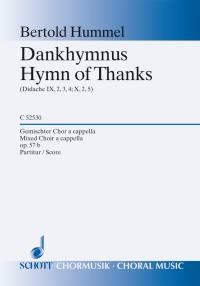Hymn
of Thanks (english/german) for 4 to 8-part mixed choir a cappella, op. 57b
(1975)
Text:
Didache IX, 2,3,4; X,2,5

First
performance: June
22, 1975, Würzburg, Kiliansdom
Würzburger Domsingknaben / Siegfried
Koesler
First
performance of english version: October
6, 2007, Usedom, Lutheran Church
Sølvguttene (Oslo) / Frederick Otterstad
Duration: 6 Minutes
Publisher: Schott Music C 52530 / ISMN: M-001-14794-1
Hymn
of Thanks
Text:
Didache IX, 2, 3, 4; X, 2, 5
We
thank Thee, oh Lord, our Father,
for the holy vine of David Thy servant,
which
You mad'st known to us through Jesus Thy Son;
to Thee be glory for ever.
We
thank Thee, oh Lord, our Father,
for the life and knowledge
which You mad'st
known to us through Jesus Thy Son;
To Thee be glory for ever.
As
this broken bread was scattered upon the hills,
and now has been gathered together
and has became one
so let Thy Church be gathered together
from the ends
of the earth into Thy kingdom;
for Thine is the glory and the power through
Jesus Christ for ever and ever.
We
thank Thee, oh Lord, our Father, for Thy holy Name
which thou didst make to
live in our hearts,
and for the knowledge, the faith and immortality,
which
Thou mad'st known to us through Jesus Thy Son;
to Thee be glory for ever.
Remember,
oh Lord, Thy Church,
to deliver her from all evil
and make her perfect
in Thy love
and gather her from the four winds
to Thy kingdom which thou
hast prepared for her.
For Thine is the power through Jesus Christ for ever.
Foreword
(Schott Music)
When
I took up my post as Director of Music at the Cathedral of St Kilian in Würzburg
in November 2002, I soon realised that the works of Bertold Hummel enjoyed frequent
performance in this cathedral. The particular fostering of the works of a composer
in his original place of activity is a common practice in Germany - but in the
case of contemporary music more an exception to the rule. This fostering surely
owes a lot to Hummel's dose ties with the Cathedral of St Kilian in Würzburg
through a variety of channels: the friendly association with the former bishop
and my predecessor, Hummel's participation in the Würzburg Cathedral Orchestra
and his dose ties to the choirs of the cathedral; his children and grandchildren
have sung or still sing in the cathedral.
It is therefore quite legitimate
to say that Bertold Hummel's Hymn of Thanks, like many of his choral works, is
inspired by the architecture and powerful acoustics of the cathedral. It was therefore
quite natural that the first performance of this composition should be given by
the Würzburger Domsingknaben [cathedral choir] in 1975. The text providing
the basis for the Hymn of Thanks is taken from the 9th and 10th chapter
of the Didache, a scripture originating in Syria ca. 100-180 AD which can probably
be said to be one of the earliest church Orders of Christianity. Hummel sets the
emphatic text passages as a Eucharist Hymn of Thanks which will also find
its niche in concerts of sacred music. Hummel's characteristic tonal language
is coupled with his remarkable intuition for the vocal possibilities of young
choirs.
A note on the performance practice: the passages indicated with "etwas
freier" [somewhat freer] which are more of a recitative nature are designed
to be performed in a fluent manner in the sense of Gregorian chants. The metrical
structure of the text is purely intended for orientation purposes.
Würzburg,
May 2007
Martin Berger
Translation: Lindsay Chalmers-Gerbracht